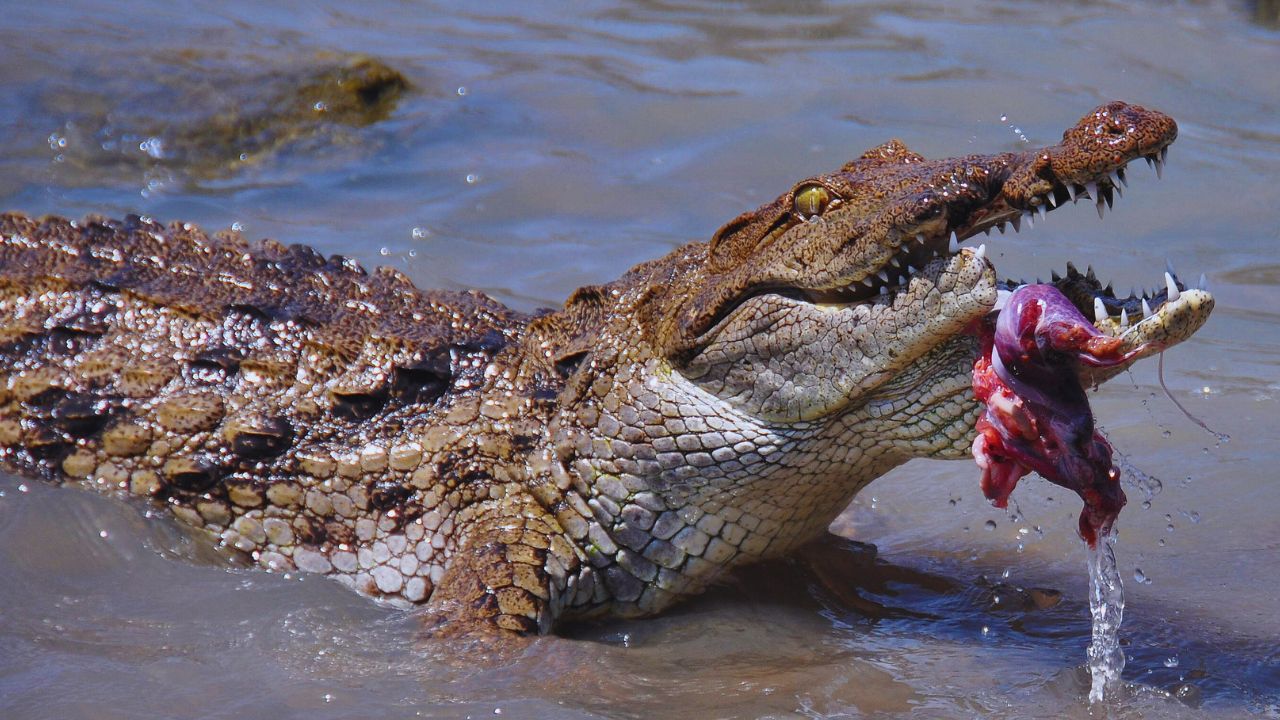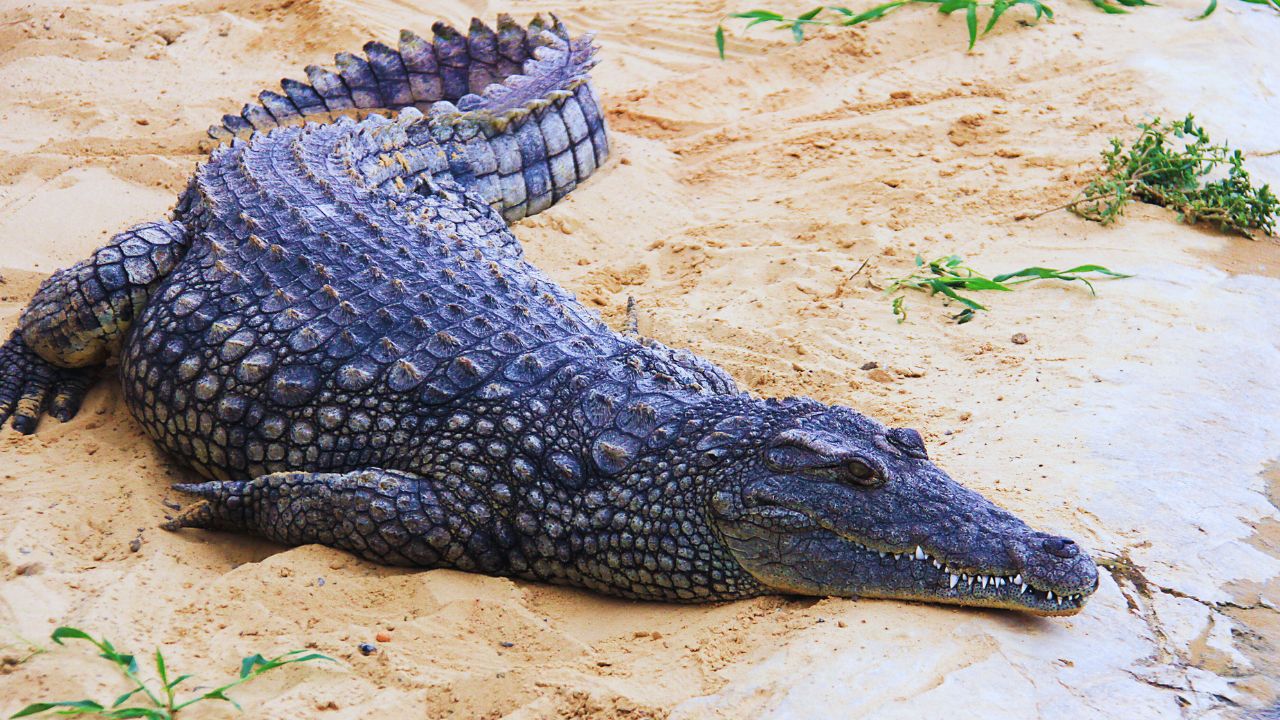Florida’s Crocodiles: Invisible Hunters Among Us?
Is it a crocodile or an alligator? You could think it’s an alligator if you’re in Florida, but are crocodiles also found there? Is it really your goal to approach them closely enough to learn how they differ? Let’s investigate the startling reality regarding Florida’s crocodiles.

What Distinguishes An Alligator From A Crocodile?
We must first comprehend the distinctions between crocodiles and alligators before we can respond to the question of whether crocodiles reside in Florida. Despite being in separate families, they are both members of the Crocodilia order. Crocodiles are members of the Crocodylidae family, while alligators are members of the Alligatoridae family. Here’s a brief analogy:
Alligators: Usually smaller (8–15 feet, 400–800 pounds), dark green or black, with a rounded snout.
Crocodiles: are typically bigger (up to 23 feet, 2,200 pounds), pale green, brown, or gray in color, and have a V-shaped snout.
Keeping these differences in mind, let’s discuss crocodiles’ existence in Florida.
Differences Between Crocodiles and Alligators
| Characteristic | Alligators | Crocodiles |
|---|---|---|
| Family | Alligatoridae | Crocodylidae |
| Size | 8–15 feet, 400–800 lbs | Up to 23 feet, 2,200 lbs |
| Snout Shape | Rounded | V-shaped |
| Color | Dark green or black | Light green, brown, or grey |
Do crocodiles live in Florida?
Indeed, Florida is home to crocodiles! Although alligators may be found all across the state, from marshes to rivers and lakes, crocodiles also live in certain places. These noteworthy spots are where you may find these secretive creatures.

Everglades National Park:
Crocodiles have the perfect home in the Everglades. The subtropical temperature of the park provides a warm environment ideal for these animals. In contrast to their violent African and Australian saltwater counterparts, American crocodiles are more timid and like brackish waterways and estuaries. Though they are not as noticeable as the park’s alligators, visitors may be able to glimpse them in places like Shark Valley, the Anhinga Trail, and Eco Pond.
Miami’s Turkey Point Power Plant:
It’s surprising to learn that the Turkey Point Power Plant is home to 25% of Florida’s crocodile population. The 5,900 acres of artificial cooling canals at the facility provide a shield against increasing sea levels and tides. Because of these features, it’s a great place for crocodiles to build their nests, with berms providing secure areas for them to deposit their eggs. The number of crocodiles has increased from endangered to threatened, thanks in part to conservation initiatives.

The Florida Keys:
The Florida Keys’ waterways are home to crocodiles as well, especially in the Upper Keys, like Islamorada. As far south as Key West and the Dry Tortugas, they have been observed. Notably, before being moved to the Everglades in 2017 for safety concerns, a crocodile by the name of Cleatus became a fixture in the area. Since crocodiles may live for up to 70 years in the wild, sightings over an extended period of time are conceivable.
Locations of Crocodiles in Florida
| Location | Details |
|---|---|
| Everglades National Park | Ideal habitat with subtropical conditions is found in brackish waters and estuaries |
| Turkey Point Power Plant, Miami | 25% of Florida’s crocodile population lives in a protected environment with man-made cooling canals |
| Florida Keys | Found in canals, particularly in Islamorada, and as far south as Key West and the Dry Tortugas |
| Crocodile National Wildlife Refuge | Saltwater mangrove habitat, park not open to the public, volunteer opportunities available |
| Rookery Bay, Naples | 110,000 acres of mangrove forests, uplands, and estuaries, ideal for crocodiles due to mix of fresh and saltwater |
| Tampa Bay | known instance of a crocodile traveling from Miami to Tampa Bay |
The Hidden Habitat of the Crocodile National Wildlife Refuge

The saltwater mangrove habitat of the Crocodile National Wildlife Refuge, which is situated in the Keys, is ideal for crocodiles. While the park isn’t accessible to the general public, volunteers may become a part of the Crocodile Lake team, providing a special chance to interact with these magnificent animals.
Naples’s Rookery Bay:
Another crocodile hotspot is Rookery Bay near Naples, which is located along the Gulf of Mexico. It covers an area of 110,000 acres and consists of estuaries, uplands, and mangrove forests. Crocodiles, which flourish in the brackish waters of the estuaries, have a natural home here due to its closeness to the western Everglades.
Tampa Bay:
Unexpectedly, a crocodile that had been tagged near Miami’s Turkey Point was discovered in Tampa Bay, 207 miles away. Although crocodiles may get up to 20 mph in brief sprints, this voyage most likely happened over many years.
Unusual Adversaries:
Large and ferocious, nile crocodiles are endemic to Africa. It’s possible that the three verified sightings in Florida in 2009, 2011, and 2014 were brought in illegally and released. Nevertheless, there is no proof that Florida is home to a healthy population of Nile crocodiles at this time.
Sanibel Island Golf Club:
It was discovered that the odd-looking alligator that a player at Sanibel Island Golf Club had reported seeing on the course in January 2017 was really a crocodile. This observation, which occurred 50 miles north of Naples, their typical habitat, illustrates the growing number of crocodiles that are found outside of their natural range.

Notable Crocodile Facts in Florida
| Fact | Details |
|---|---|
| Lifespan | Crocodiles can live 50–70 years in the wild |
| Speed | Can reach speeds of 20 mph in short bursts |
| Nile Crocodiles | Sighted in Florida in 2009, 2011, and 2014, likely due to illegal importation and release, there is no established population |
| Sanibel Island Golf Club Encounter | Crocodiles were sighted in January 2017 outside typical habitat, highlighting their increasing presence in new areas |
| Conservation Efforts | Conservation efforts at places like Turkey Point have helped change their status from endangered to threatened |
Answers to Common Questions (FAQ)
1. What are the principle differences between crocodiles and alligators?
Answer:
The foremost variations between crocodiles and alligators consist of:
Family: Crocodiles belong to the Crocodylidae family, even as alligators are a part of the Alligatoridae family.
Size: Alligators are typically smaller (eight–15 feet, 400–800 lbs), whereas crocodiles can grow larger (up to 23 toes, 2,200 lbs).
Snout Shape: Alligators have a rounded snout, while crocodiles have a V-formed snout.
Color: Alligators are generally dark, inexperienced, or black, while crocodiles are light green, brown, or grey.
2. Are there crocodiles in Florida?
Answer:
Yes, there are crocodiles in Florida. They inhabit precise regions, which include the Everglades National Park, Turkey Point Power Plant in Miami, the Florida Keys, Crocodile National Wildlife Refuge, and Rookery Bay in Naples. They have also been sighted as far north as Tampa Bay.
3. Where can you find crocodiles inside the Everglades National Park?
Answer:
Crocodiles within Everglades National Park decide on brackish waters and estuaries. While they’re less seen than alligators, site visitors could possibly spot them in areas like Shark Valley, the Anhinga Trail, and Eco Pond. The Everglades’ subtropical conditions offer a super habitat for crocodiles.
4. How did crocodiles come to live on the Turkey Point Power Plant in Miami?
Answer:
The Turkey Point Power Plant in Miami hosts 25% of Florida’s crocodile population because of its 5,900 acres of man-made cooling canals. These canals offer a protected environment, free from tides and rising water levels, making them an extremely good nesting ground for crocodiles. Conservation efforts in 1978 have helped save and protect the crocodile population in this place.
5. Have there been any sightings of Nile crocodiles in Florida?
Answer:
Yes, there were sightings of Nile crocodiles in Florida in 2009, 2011, and 2014. These sightings were possibly due to unlawful importation and launch. However, there is no proof of a longtime population of Nile crocodiles in Florida nowadays. Nile crocodiles are native to Africa and are recognized for their large length and aggressive behavior.





